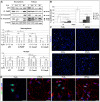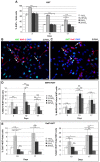Mild hypoxia enhances proliferation and multipotency of human neural stem cells
- PMID: 20052410
- PMCID: PMC2797394
- DOI: 10.1371/journal.pone.0008575
Mild hypoxia enhances proliferation and multipotency of human neural stem cells
Abstract
Background: Neural stem cells (NSCs) represent an optimal tool for studies and therapy of neurodegenerative diseases. We recently established a v-myc immortalized human NSC (IhNSC) line, which retains stem properties comparable to parental cells. Oxygen concentration is one of the most crucial environmental conditions for cell proliferation and differentiation both in vitro and in vivo. In the central nervous system, physiological concentrations of oxygen range from 0.55 to 8% oxygen. In particular, in the in the subventricular zone niche area, it's estimated to be 2.5 to 3%.
Methodology/principal findings: We investigated in vitro the effects of 1, 2.5, 5, and 20% oxygen concentrations on IhNSCs both during proliferation and differentiation. The highest proliferation rate, evaluated through neurosphere formation assay, was obtained at 2.5 and 5% oxygen, while 1% oxygen was most noxious for cell survival. The differentiation assays showed that the percentages of beta-tubIII+ or MAP2+ neuronal cells and of GalC+ oligodendrocytes were significantly higher at 2.5% compared with 1, 5, or 20% oxygen at 17 days in vitro. Mild hypoxia (2.5 to 5% oxygen) promoted differentiation into neuro-oligodendroglial progenitors as revealed by the higher percentage of MAP2+/Ki67+ and GalC+/Ki67+ residual proliferating progenitors, and enhanced the yield of GABAergic and slightly of glutamatergic neurons compared to 1% and 20% oxygen where a significant percentage of GFAP+/nestin+ cells were still present at 17 days of differentiation.
Conclusions/significance: These findings raise the possibility that reduced oxygen levels occurring in neuronal disorders like cerebral ischemia transiently lead to NSC remaining in a state of quiescence. Conversely, mild hypoxia favors NSC proliferation and neuronal and oligodendroglial differentiation, thus providing an important advance and a useful tool for NSC-mediated therapy of ischemic stroke and neurodegenerative diseases like Parkinson's disease, multiple sclerosis, and Alzheimer's disease.
Conflict of interest statement
Figures








Similar articles
-
Immortalization of human neural stem cells with the c-myc mutant T58A.PLoS One. 2008 Oct 2;3(10):e3310. doi: 10.1371/journal.pone.0003310. PLoS One. 2008. PMID: 18836552 Free PMC article.
-
Effects of oxygen concentration on the proliferation and differentiation of mouse neural stem cells in vitro.Cell Mol Neurobiol. 2008 Sep;28(6):833-45. doi: 10.1007/s10571-007-9237-y. Epub 2008 Jan 31. Cell Mol Neurobiol. 2008. PMID: 18236013 Free PMC article.
-
In vitro investigation of the mechanism underlying the effect of ginsenoside on the proliferation and differentiation of neural stem cells subjected to oxygen-glucose deprivation/reperfusion.Int J Mol Med. 2018 Jan;41(1):353-363. doi: 10.3892/ijmm.2017.3253. Epub 2017 Nov 13. Int J Mol Med. 2018. PMID: 29138802 Free PMC article.
-
Hypoxia in the regulation of neural stem cells.Cell Mol Life Sci. 2011 Sep;68(17):2831-44. doi: 10.1007/s00018-011-0723-5. Epub 2011 May 17. Cell Mol Life Sci. 2011. PMID: 21584807 Free PMC article. Review.
-
New Insights into the Role of Mild Hypoxia in Regulating Neural Stem Cell Characteristics.Stem Cells Dev. 2024 Jul;33(13-14):333-342. doi: 10.1089/scd.2024.0020. Epub 2024 Jun 11. Stem Cells Dev. 2024. PMID: 38753713 Review.
Cited by
-
3D differentiation of neural stem cells in macroporous photopolymerizable hydrogel scaffolds.PLoS One. 2012;7(11):e48824. doi: 10.1371/journal.pone.0048824. Epub 2012 Nov 7. PLoS One. 2012. PMID: 23144988 Free PMC article.
-
Hyperoxygenation During Mid-Neurogenesis Accelerates Cortical Development in the Fetal Mouse Brain.Front Cell Dev Biol. 2022 Mar 17;10:732682. doi: 10.3389/fcell.2022.732682. eCollection 2022. Front Cell Dev Biol. 2022. PMID: 35372333 Free PMC article.
-
Influence of oxygen tension on dopaminergic differentiation of human fetal stem cells of midbrain and forebrain origin.PLoS One. 2014 May 2;9(5):e96465. doi: 10.1371/journal.pone.0096465. eCollection 2014. PLoS One. 2014. PMID: 24788190 Free PMC article.
-
Cortical glial fibrillary acidic protein-positive cells generate neurons after perinatal hypoxic injury.J Neurosci. 2011 Jun 22;31(25):9205-21. doi: 10.1523/JNEUROSCI.0518-11.2011. J Neurosci. 2011. PMID: 21697371 Free PMC article.
-
Neural precursor cells cultured at physiologically relevant oxygen tensions have a survival advantage following transplantation.Stem Cells Transl Med. 2013 Jun;2(6):464-72. doi: 10.5966/sctm.2012-0144. Epub 2013 May 15. Stem Cells Transl Med. 2013. PMID: 23677643 Free PMC article.
References
-
- Vescovi AL, Parati EA, Gritti A, Poulin P, Ferrario M, et al. Isolation and cloning of multipotential stem cells from the embryonic human CNS and establishment of transplantable human neural stem cell lines by epigenetic stimulation. Exp Neurol. 1999;156:71–83. - PubMed
-
- McKay R. Stem cells in the central nervous system. Science. 1997;276:66–71. - PubMed
-
- Gritti A, Cova L, Parati EA, Galli R, Vescovi AL. Basic fibroblast growth factor supports the proliferation of epidermal growth factor-generated neuronal precursor cells of the adult mouse CNS. Neurosci Lett. 1995;185:151–154. - PubMed
Publication types
MeSH terms
Substances
LinkOut - more resources
Full Text Sources
Other Literature Sources
Miscellaneous

